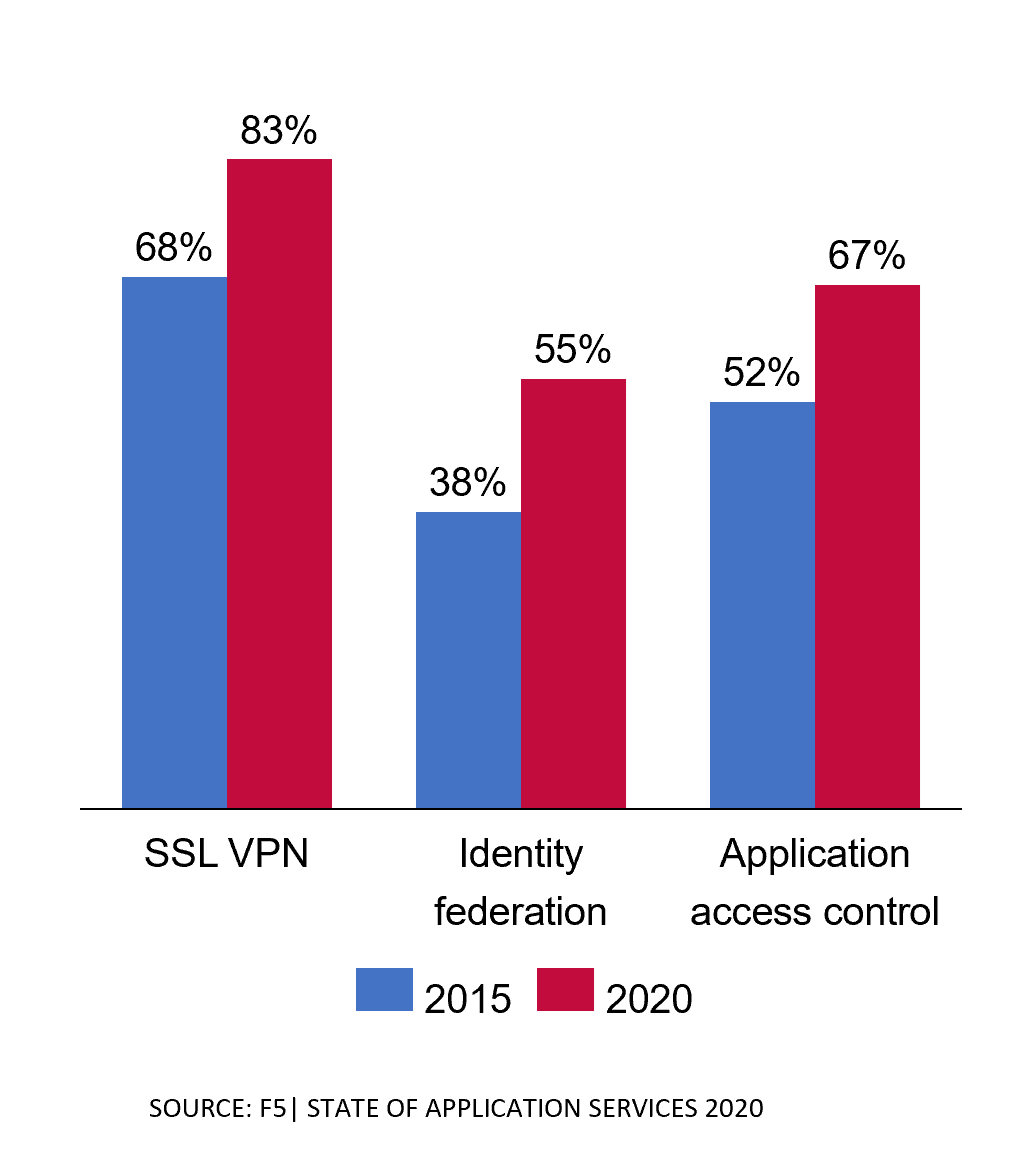About a month ago, we published our sixth annual State of Application Services (SOAS) report. We posited from the beginning that since application services sit between the application and the end user, they are the essential ingredients to any and every successful application interaction. Application services deliver high quality customer experiences to drive engagement, optimize communications across multi-cloud architectures, and effectively implement security to build trust.
In 2015, we predicted application services would become even more important as applications and data expanded across different clouds and digital transformation was creating new ecosystems and new business models. Adoption rates have proven our prediction with increased adoption rates across just about every app service. A few examples include:
- WAF Protection is now at 71% in 2020, up from 56% in 2015
- DDoS Protection deployments are up to 70% from 53% in 2015
- Load balancing, already widely deployed in 2015 is up 4 points to 74% from 2015 levels
As the realities of COVID-19 come into clearer focus, so too is the important role application services are playing. As organizations rapidly mobilize a global workforce to work from home, they are considering the performance, availability, and security of their corporate applications. In our conversations with customers and partners around the world over the past month, we see a renewed focus on some of the same application services that topped the list in 2015—load balancing, network firewall, anti-virus, and most importantly, identity and access.
While most organizations have the infrastructure in place to accommodate a limited percentage of employees working remotely at any given time, rarely have organizations needed to scale into the tens and even hundreds or thousands—all within a week or two. Application services federate user identity and enable single sign on for seamless and secure user experiences globally. Based on our data from the last six years, most organizations were at least prepared with a framework architecture in place to scale. Some key indicators include:
- SSL VPN deployments are now at 83%, up from 68% in 2015
- Identity federation reached 55% from 38% in 2015
- Application access control deployments are up to 67% from 52% in 2015

One application service that remained steady was virtual desktop infrastructure (VDI) with 38% in 2015 and 39% in 2020. We suspect these rates are rising steadily this month as VDI enables employees to access their desktops from a home PC, giving organizations time to deploy laptops and other needed equipment. Similarly, load balancing, global server load balancing, and DNS provide critical capacity and bandwidth monitoring to ensure consistent performance during periods of peak usage.
It has been speculated that one long-term outcome from the COVID-19 crisis is an acceleration of digital transformation initiatives. For this to happen, application services will need to continue playing an increasingly important role in how applications are managed and protected. These services are freeing application delivery from physical infrastructure concerns, unlocking application and business insights and applying the highest efficacy against the security threat landscape. If trends from the past six years hold true for the next six, these predictions are very much in the realm of possibility.
Every year Lori MacVittie and I look forward to analyzing the results—it is truly a gift that the thousands who have taken the time to tell us about their deployments and use of application services give us every year. We are sincerely thankful, and wish safety and health to all.
Get the 2020 State of Application Services Report, and follow the conversation with @f5networks and the hashtag #AppServices.
About the Author

Related Blog Posts

Nutanix and F5 expand successful partnership to Kubernetes
Nutanix and F5 have a shared vision of simplifying IT management. The two are joining forces for a Kubernetes service that is backed by F5 NGINX Plus.

AppViewX + F5: Automating and orchestrating app delivery
As an F5 ADSP Select partner, AppViewX works with F5 to deliver a centralized orchestration solution to manage app services across distributed environments.

Build a quantum-safe backbone for AI with F5 and NetApp
By deploying F5 and NetApp solutions, enterprises can meet the demands of AI workloads, while preparing for a quantum future.

F5 ADSP Partner Program streamlines adoption of F5 platform
The new F5 ADSP Partner Program creates a dynamic ecosystem that drives growth and success for our partners and customers.
F5 NGINX Gateway Fabric is a certified solution for Red Hat OpenShift
F5 collaborates with Red Hat to deliver a solution that combines the high-performance app delivery of F5 NGINX with Red Hat OpenShift’s enterprise Kubernetes capabilities.
Phishing Attacks Soar 220% During COVID-19 Peak as Cybercriminal Opportunism Intensifies
David Warburton, author of the F5 Labs 2020 Phishing and Fraud Report, describes how fraudsters are adapting to the pandemic and maps out the trends ahead in this video, with summary comments.
